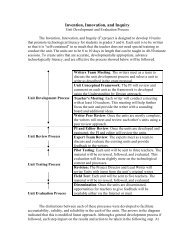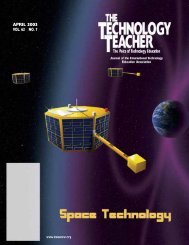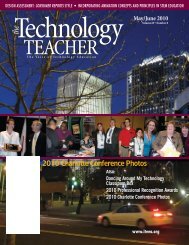MARCH 2001 VOL. 60 NO. 6 - International Technology and ...
MARCH 2001 VOL. 60 NO. 6 - International Technology and ...
MARCH 2001 VOL. 60 NO. 6 - International Technology and ...
You also want an ePaper? Increase the reach of your titles
YUMPU automatically turns print PDFs into web optimized ePapers that Google loves.
Each satellite orbits at an altitude of nearly 11,000<br />
miles. This altitude was chosen so that each satellite would<br />
orbit once every 12 hours, or twice a day. The GPS<br />
consists of three parts:<br />
1. The satellites.<br />
2. The ground control stations.<br />
3. The end-user GPS receivers.<br />
The Nuts <strong>and</strong> Bolts<br />
1. Twenty-four GPS satellites in medium Earth orbit<br />
each have onboard atomic clocks to provide<br />
extremely accurate time.<br />
2. Ground stations track the exact locations<br />
of each satellite <strong>and</strong> keep the clocks synchronized<br />
with each other.<br />
3. Each GPS satellite transmits an accurate<br />
position <strong>and</strong> time signal. GPS receivers<br />
on other satellites, such as Jason-1, not<br />
only receive the position <strong>and</strong> time information<br />
from the signal, but also take<br />
into account the Doppler effect on the<br />
signal itself. That is, when two satellites<br />
(for example, a GPS satellite <strong>and</strong> Jason-<br />
1) are moving closer to each other, the<br />
radio signal at the receiving satellite<br />
appears a bit squished. If the two<br />
satellites are moving farther apart, the received radio<br />
signal appears a bit stretched out. The receiving<br />
satellite “knows” how the signal should look (that is,<br />
its wavelength when it was transmitted), so the<br />
Doppler shift tells how fast <strong>and</strong> in what direction<br />
the two satellites are moving with respect to each<br />
other.<br />
The receiver (such as the one on Jason-1) measures<br />
the time delay for the signal to reach it (as well<br />
as the Doppler shift). This delay is the direct measure<br />
of the distance to the satellite. Measurements<br />
collected simultaneously from four (or more) satellites<br />
are processed to solve for the three dimensions<br />
of position, velocity, <strong>and</strong> time.<br />
What Else Can GPS Do?<br />
You can go to the Internet site http://gpshome.ssc.nasa.gov<br />
<strong>and</strong> learn about ways GPS is used all over the world. Try<br />
to come up with a list of 5 to 10 different uses. Break<br />
them into the following categories <strong>and</strong> describe them:<br />
Location: Determining a basic position<br />
Navigation: Getting from one location to another<br />
Tracking: Monitoring the movement of people <strong>and</strong><br />
things.<br />
Mapping: Creating maps of the world.<br />
Timing: Bringing precise timing to the world.<br />
You can also find very good interactive tutorials about<br />
GPS on the Web.<br />
This article was contributed by the Jet Propulsion Laboratory,<br />
California Institute of <strong>Technology</strong>, reflecting research carried<br />
out under a contract with the National Aeronautics <strong>and</strong> Space<br />
Administration. It was written by Enoch Kwok <strong>and</strong> Diane<br />
Fisher. Mr. Kwok is a high school teacher <strong>and</strong> consultant.<br />
Ms. Fisher is a science <strong>and</strong><br />
technology writer <strong>and</strong><br />
designer of The Space Place,<br />
a website with fun <strong>and</strong><br />
educational space-related<br />
activities at http://<br />
spaceplace.jpl.nasa.gov.<br />
For more about the oceans <strong>and</strong> El<br />
Niño <strong>and</strong> a recipe for delicious <strong>and</strong> educational “Blame El<br />
Niño Pudding,” go to http://spaceplace.jpl.nasa.gov/<br />
topex_make1.htm. For more information about the<br />
Jason-1 mission, see http://topex-www.jpl.nasa.gov/jason1/.

















